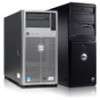Dell PowerEdge T605 Hardware Owner's Manual (PDF) - Page 170
Troubleshooting the System Battery
 |
View all Dell PowerEdge T605 manuals
Add to My Manuals
Save this manual to your list of manuals |
Page 170 highlights
Action CAUTION: Only trained service technicians are authorized to remove the system cover and access any of the components inside the system. Before performing any procedure, see your Product Information Guide for complete information about safety precautions, working inside the system and protecting against electrostatic discharge. 1 Open the system. See "Opening the System" on page 68. 2 Ensure that the following components are properly installed: • Expansion cards • Power supplies • Fans • Processors and heat sinks • Memory modules • Drive-carrier connections to the SAS/SATA backplane, if applicable 3 Ensure that all cables are properly connected. 4 Close the system. See "Closing the System" on page 70. 5 Run the system board tests in the system diagnostics. See "Running the System Diagnostics" on page 193. If the tests fail, see "Getting Help" on page 205. Troubleshooting the System Battery Problem • System message indicates a problem with the battery. • System Setup program loses system configuration information. • System date and time do not remain current. NOTE: If the system is turned off for long periods of time (for weeks or months), the NVRAM may lose its system configuration information. This situation is caused by a defective battery. Action 1 Re-enter the time and date through the System Setup program. See "Entering the System Setup Program" on page 43. 170 Troubleshooting Your System















